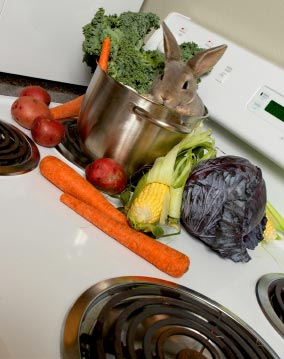Can Improving Your Diet Improve Your Business?

In which I eat “rabbit food” for a month
in my quest to feel better.Most of us who are business owners — and even those who are happy hard workers — seem to have a disconnect between our personal lives and our business. We work late into the night, eating fast food or microwaving something “quick”. In many cases, we don’t have time to cook healthier food or even go to a restaurant and sit down to eat.
We also skip routine health checkups and don’t go get health problems looked at unless they are acute (a.k.a. affecting our work!) Our bad diet and stress are huge risk factors, but since many health conditions take years to show up, we rationalize and assure ourselves that we’re “fine.”
I was shocked to figure out how far our “standard American diet”, or SAD (ironic acronym!) is from what humans ate hundreds or thousands of years ago and are evolutionarily accustomed to. Not only that, but pretty much every major disease that happens to us later in our lives is caused by bad diet.
Once I realized this, I became completely overwhelmed by the cacophony of diet books and websites giving me different “must-have” diets. Some diets say to eat mostly protein. Some say to eat no more than 40-50g of protein a day, since any more and our bodies can’t properly digest it. Some believe in eating vegan or raw. Some say meat is a healthy part of a balanced diet. And on, and on, and on…for pretty much any food you ingest, you’ll find those on both sides debating its merits.
To make matters worse, if you’re busy with work and can’t afford to take time off, it’s no wonder you probably are eating poorly. After all, since the diets all tell you different things, why not just avoid them all? You rationalize that they will probably make you feel worse anyway, or at least not make you feel better, and so you stick with what you know.
The good news is I’m not here to “sell” you on any particular diet. In this blog post, I’ll explain four simple steps I used to rework my diet, and how I made it work with little interruption to my regular life. I’ll give you suggestions on how you can go about reworking your diet with a limited amount of time available. Finally, I’ll give you some resources and tips as to where you can start.
Step 1: Set An Intention
By setting an intention, I don’t mean something like “Lose 10 pounds in the next 2 months.” That’s time-defined, so it’s a goal. Goals are good, but in this case, they encourage crash diets. Instead, try setting an intention.
When I started this journey in 2006, my intention was to stop crashing hard after lunch and feeling like I needed to nap. I eventually eliminated alcohol, caffeine, and sugar, and stopped the crashing. That’s the power of an intention.
When I changed my diet again at the beginning of this month, my intention was to have more energy and to feel more vitality for the rest of my life. I was, frankly, tired of being tired. Even though I was no longer eating much sugar, I was still crashing in the afternoons. I wanted this to stop — or at least be a meditation time instead of a nap!
You have to have an intention for your diet to work. You have to know who you want to be on the other side of this diet change, and you have to understand what you want at a fundamental level. You can’t change your diet to please someone else. Also, a superficial change like “lose 10 pounds” will not stick with you long-term. Find a change that inspires you to move forward and will motivate you to change for the rest of your life.
In my case, I knew if I had huge gains in energy, it would be fairly easy to stick with even a restrictive diet. If I ever had cravings for the “old” foods, I could simply look back at how awful they made me feel and instantly the craving would go away. (By the way, it doesn’t matter if the foods you don’t want truly made you feel awful in the past or not. If you create that association strongly enough, “true” or not, you will never want those foods again.)
Step 2: Keep A Food Journal
I started keeping a journal of what I ate. I correlated this with how I felt after I ate those items. Lunch was the worst meal for me — I often felt tired after I ate it — so I started there.
Fairly quickly, I was able to identify a pattern. The more “heavy” meat I ate, the worse I felt. The same went with sugar…not just obvious sugar like candy, but “hidden” sugar found in things like white bread and starchy pasta.
I tried several different ways to cope with this, but I found the more vegetarian I made my lunch, the less sleepy I was. Fruits and vegetables only were best. Veggies with some bread made me tired, but not to the point of napping. Anything with red meat, and I was out like a log…napping for at least an hour.
I did some research, and found an interesting and mostly unknown chemical called Neu5Gc. You probably haven’t heard of it, and neither have I. Some scientists, however, believe that our inability to digest this chemical is part of what causes many chronic diseases. Here’s the article explaining what Neu5Gc is.
The most interesting part of the article, to me, was this:
“After testing a range of foods, they found the highest levels of Neu5Gc in red meat: up to 11,600 micrograms could be absorbed from the recommended daily serving of beef, 5,100 from pork and 4,900 from lamb. The level in goat’s cheese was 5,500, but fell to around 700 in milk and salmon. Cod, tuna, turkey and duck were in the twenties.”
Could it be that our bodies’ inability to digest Neu5Gc causes us to be tired after we eat? I can’t tell you for sure, but this was one of the only articles I found that mapped out my symptoms’ severity.
You can see why keeping a food journal is so important. Not only does it help you to see what is causing your problems — from simply eating too much to a symptom like feeling tired — but it helps you test small changes in your diet so that you can correct your imbalances.
Step 3: Make The Changes!
After investigating, I decided to implement a 30-day trial of going pescetarian. In fact, if you’re reading this Monday, December 8, 2008, that’s the last day of my 30-day trial.
I easily completed the trial. In fact, I was shocked at how easy it was for me to stop eating most meat. Pretty much every restaurant has some sort of fish or seafood entree, or even a simple salad. Instead of my local burrito place, I found a new one that had yummy fish burritos (and still made regular meat burritos for Richard.) I tried a new Chinese place that had good shrimp fried rice. I really enjoyed myself! I felt completely abundant and, even when Richard cooked grass-fed ribeye steak a few nights during the trial, I had absolutely no cravings for it.
There are definitely a few things I miss, namely In-N-Out burgers and carnitas burritos. But overall, I didn’t miss them so much that I stopped the trial. Will I go back to eating them? Possibly occasionally, but I doubt I will eat meat that often. The effect of not eating meat — feeling happier, more energetic, and less tired in the afternoons — is far more than any benefit I would get from putting it back in my diet on a regular basis.
Toward the end of my 30-day Pescetarian trial, I did a liver flush. My entire blog entry on the liver flush will be up later this week, but suffice it to say, I had some amazing changes.
Step 4: Accept Yourself – It’s OK To Be Different
This is pretty straightforward, but many people don’t do it: You have to get out of your old thought patterns and try new things in order to find what works best for you. What works best for you in terms of diet is probably not what you’re doing right now. In fact, for most of us, those two thoughts are at opposite ends of the spectrum!
At the beginning of my 30-day trial, I was at a conference where they had a BBQ. While everyone else enjoyed ketchup-covered hot dogs and hamburgers, I ate a salad with black olives and some tuna salad. Some were joking about me eating “rabbit food”, but I shrugged it off and smiled. I knew that what I was eating would make me feel good. That was all I needed.
Not drinking alcohol or caffeine, not eating sugar, and not eating most meat can be difficult socially. I suggest you try one small thing at a time. Your friends will understand, and if they tease you, just remember — it’s because they love you. Or maybe it’s secretly because they are jealous of your “rabbit food.” 😉
Conclusion
Changing your diet is one of the most worthwhile things you can do to improve your health — both short-term and long-term. Just remember, you don’t “need” to be tired after lunch or out of breath when you climb the stairs. Food doesn’t have to make you sleepy, or gassy, or sick. What you eat is a choice. With some trial and error and persistence, you can find a diet that works for you. Just don’t be surprised if it’s quite different from what you eat now!
Start here:
- Health and Fitness forum on StevePavlina.com. Steve’s blog posts about going vegan and then raw inspired me to think more about my diet and how it was affecting my life. This forum is full of people who can help you, and the archives have a gold mine of information on diet.
- Feeling tired after lunch? This is my blog entry from 2006, when I discovered that I am hypoglycemic — and what that meant.
- Andreas Moritz’s The Amazing Liver Flush. I did it! Also has good background on why our culture is so sick all the time. I don’t subscribe to everything he says, but I do feel it’s worth reading.
- Raw Food Made Easy. Raw food recipes are tasty and easy to make — even for those of us who work long hours. See for yourself!


